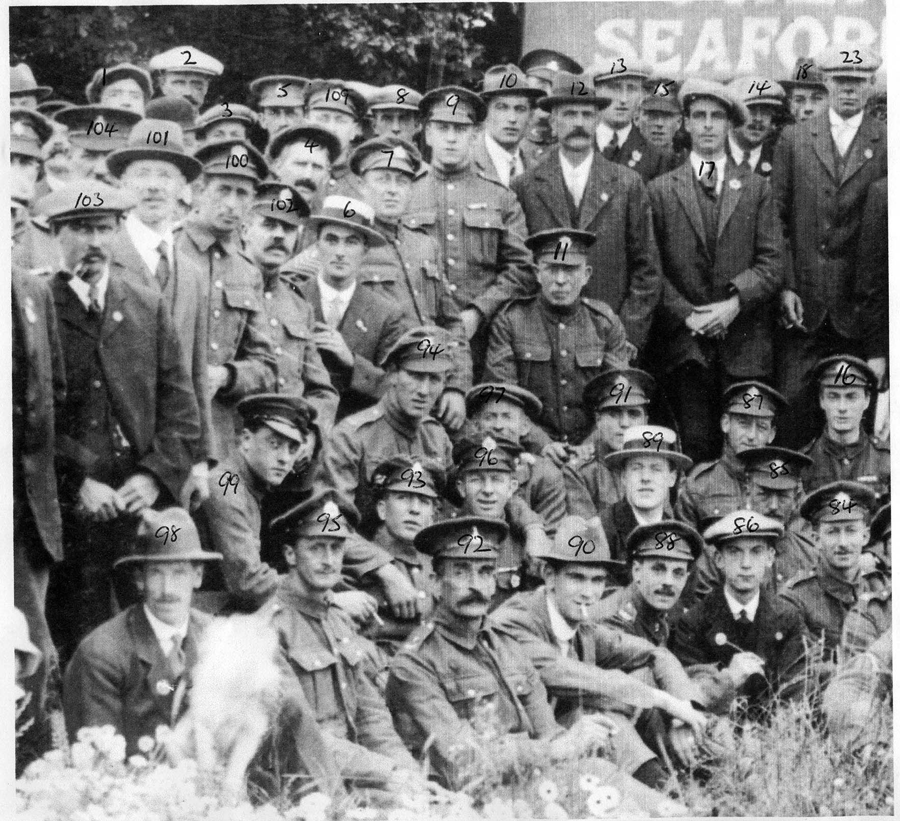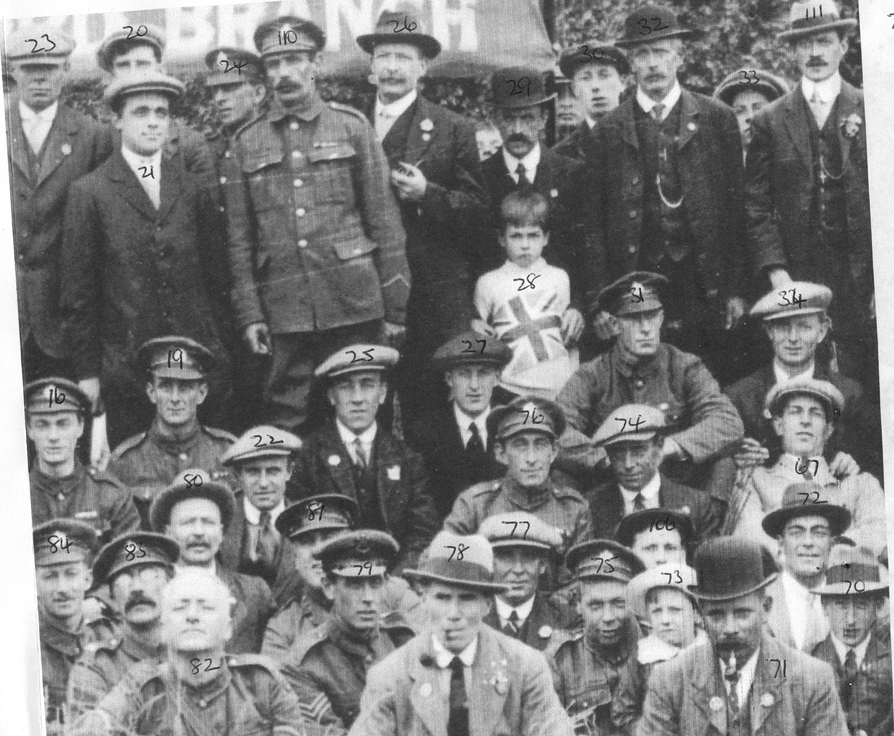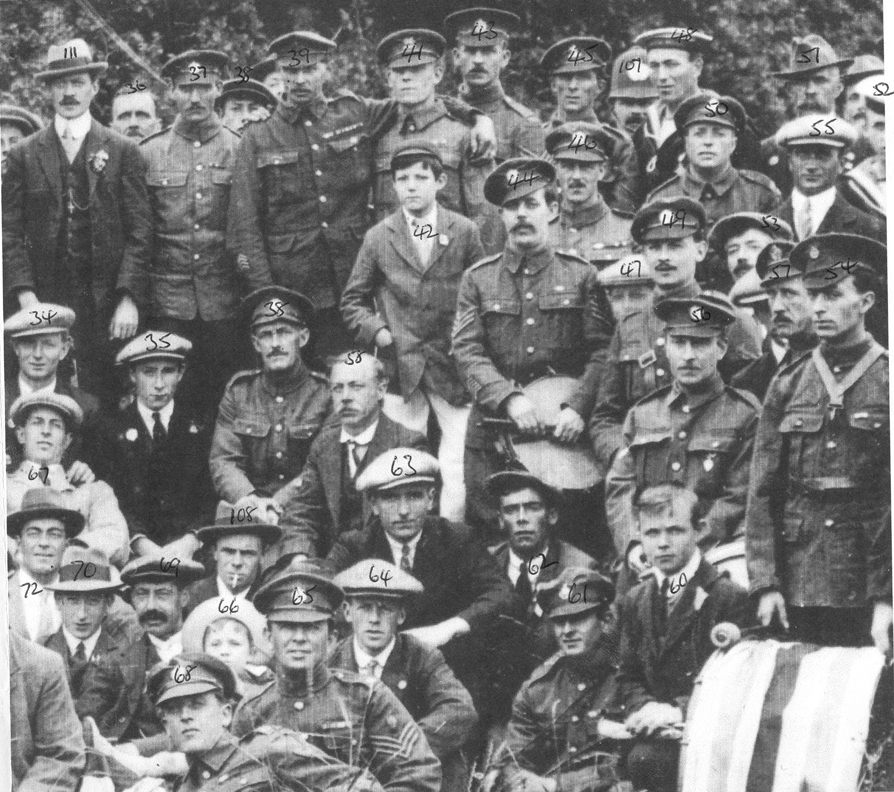Further down the page you will find some reminiscences from Seafordians, of their time in the Great War. We will post others as and when we find them. We start this page with the photograph, and the Seaford Times project of…………..
COMRADES OF THE GREAT WAR (SEAFORD BRANCH)
To commemorate the 100th anniversary of Seaford in the Great War, 1914 – 1918, we are displaying the wonderful photograph of the Seaford Branch of the ‘Comrades of the Great War’. The ‘Comrades of the Great War’ were formed in 1917 and later, in 1921, joined three other similar societies to became the British Legion.
This photograph has over 100 Seaford members, the majority of them having returned home after the hostilities ceased.
We have enlarged this photograph to enable you to see all these men clearly, in the hope that you may recognise your grand-father, or great grand-father. This is an historic photograph, and is of great importance to the history of our town. It is for that reason that we want to have as many of these Seaford men named as possible. We do have 64 names listed for this photograph, thanks to the late Mr. Walter Pettitt, but we are not sure to whom all the names belong. If your Seaford family name is in the list, please dig out your old family photos to see if there is a match with anyone in this photograph of 1919-1920.
All the men have been numbered to make it easier for you to name anyone you know. This is a huge project, and will take a very long time to complete, if in deed it ever does get completed. These Seafordians should all be remembered, and we should all know who they are.
If any of your ancestors took part in the Great War, whether they survived the war or not, please consider sending a scanned image of them to seaford.times@gmail.com They will then be remembered forever in what will become an historic visual record for future generations.
Here is our list of names for the photos below.
Mr. Avery; Mr.Batholomew, ‘Donkey’; Harry Bailey, (Carpenter); Clem Berry; Arthur Boniface; Mr.Bowley (Bowlie); George ‘Tosh’ Burgess; Stan Burtenshaw; Mr. Cale; Mr. Cheal; Tim Collins, (Good footballer); Compo Bill; Jack Cosstick; Ben Elliott; Bill ‘Stosh’ Elliott, Bill; Mr. Ernsbanks, ‘Muddy’ or Ernest Banks; Mr. Ellis (Painter); Ernie Fears; Fred Foster; T. Gates; ‘Tosh’ Green; Mr. Hamper; Joss? Harriott (Sailor); Mr. Huntly (Next to little man in hat); Mr. Hutchinson; Mr. Isted.(Poultry shop bottom High St.); Fred Kennett; Jess? Fred Lambert; Charlie Lambert; Horace Layen; Mr. Macey; Ralph Morling; Gaynor Parks; Mr. Pettitt; Bill Rhen; Fred Sexton; Les Seymour; Mr. Simmons. (Labourer); Bert Simmons; Mr. Stafford; Jimmy Wild; Bob Willis; Walt Woolgar (Old Tree).

Albert Coffen (4) William ‘Nobby’ Clarke. (10); George (Bunny) Peckham (11) Mr. Hollingdale Snr. (12); Algie Burtenshaw (13); Horace Burtenshaw (17); Fred Bowley (84) Harold Foster (Cap) (86); Ernie Morgan (91); Mr. J. Cornish (92); Tom Peckham (96); Jo Yeo. (95); Mr. Snushell. (101); Mr.Wood (102); Mr. Huntley (97) Alf Simmons (103)

Jim Wood, (21); Harry Parks (110); Fred Thompsett (22); or Charlie Macey (22) Fred Sexton (25) Horace Layen (27) Fred Cheal (29) Tom ‘Sandy’ Norman,(34); Charlie Hamper. (Bowler hat & pipe) (71)Fred Lambert (67 or 72) ‘Blower’ Parks (75); Jess Lambert (77)

Charlie Lambert (35) Sid Stace, (next to policeman) (45); Pug’ Pettitt (53) ; Jack Cosstick (63) Arthur ‘Sticky’ Fowler (64) Bobby Green,.(Sgt) (65); Percy Kennett, (Laying down) (68); Ben Foord, Policeman (107); Les Seymour (108) Mr. Isted? (111)

(Mrs. Winifred Mandeville. From an interview with Sue Baird of the Seaford Gazette, June 1988)
EVERY year on Armistice Day Mrs. Winifred Mandeville proudly wears the uniform that was her only dress for two- and-a-half years during the Great War. At the age of 92, Mrs. Mandeville, of Mercread Road, Seaford, vividly recalls her memories of service in France as part of the first ever women’s army corps. Her experiences are meticulously recorded in handwritten memoirs which she wrote over 10 years ago and they provide a remarkable insight into life at the time. Today no-one thinks twice about women joining the army or air force but 71 years ago it was a totally new idea which many people found difficult to accept.
It was early 1917 when young Winifred Wilcox heard women were wanted for the army and she decided it was time to look for a ‘new experience.’ Rejected As she was already doing war work turning out shells for a Liverpool firm, she was turned down on her first application. Undeterred, she gave in her notice and got another job which enabled her to join up as a member of the Women’s Army Auxiliary Corps. Miss Wilcox, as she was then, was one of 30 young women picked to serve in France where they were based at Pont de Larche. But life was not a bed of roses as they soon discovered. “The French did not like us as they lost boyfriends to the English girls and they would even spit at us. But after a few months they got used to us” she explained. It was not only the French who were hostile to the girls. The English engineers and soldiers were often off-hand because they worried that the girls had been sent out to replace them! When young Winifred returned home to Liverpool for leave, she discovered the women’s army was resented. “Somehow they had got the wrong idea about us. The press printed awful things about the women’s army saying there were boat-loads of pregnant girls coming back from France.” Winifred and her friends learnt of the press reports from cuttings sent to them by their families. After the cuttings were delivered to their commandant, the girls were told that due to ‘incorrect’ reports printed in the press, Queen Mary was to give her name to their cause and the corps was to be re-named the Queen Mary’s Army Auxiliary Corps. “That was very nice” said Mrs. Mandeville, but it didn’t do much to quench the bitterness we felt towards the people at home who were reading and believing and cutting out the slanderous reports and sending them out to us.” Times were hard during the war for the girls and food was very frugal. “At one time during the ‘Big Push’ in 1918 we had bread rationed for six weeks. We lived on great big biscuits but even they were hard to come by. We were marched to work with nothing but a cup of tea in us so we went on strike. We stayed in our hut and wouldn’t come out,” she said. When the girls begged for more biscuits, Mrs.Mandeville said. “We had to crack the biscuits with a hammer to get the maggots out.” She felt great sympathy for the German prisoners of war and often she and the other girls would break the rules and food they could not eat would be placed in the bin and a signal given to one of the Germans to come along and empty the dinner into his pocket. “They would never forget their manners,” said Mrs. Mandeville, “they would always give a smart salute on getting the food and vanish quickly.” She praised their thoughtfulness when the girls were lifting heavy objects or needed assistance with work. “They would see us struggling at the top of the ladder and say, “I’ll help you miss.” That was how I judged them — some of our own would see you struggle and walk on.” Even on Armistice Day when she felt ‘indescribable elation’ she felt sorrow for the German soldiers. “They stood there to attention crying, the tears streaming down their cheeks. I cried too, it was awful. It was heart-rending.” Despite the hardships, the girls had their times of fun and many boyfriends from the Royal Flying Corps, with whom the QMAAC served.
“I had my boyfriends, lots of them until I found a steady. We got engaged on Armistice Day.” Arthur Mandeville was later to become Winifred’s husband after the war. Stories of her life in camp reveal her sense of adventure. “I was confined to camp more than once,” she laughed. During the entire two- and-a-half years, Mrs. Mandeville had only one dress and two overalls. “I couldn’t say how many times I washed it in that time. It’s a bit tatty now but I’ve still got it and I wear it every Armistice Day.” She admitted. One of the happiest memories was meeting the founder of the women’s corps, Dame Helen Gwynne Vaughan, in 1949 at a reunion party. “She told me all about how she had fought to get us recognised as a section of the British Army.”
Winifred Wilcox was demobbed in 1919, and returned to England to marry Arthur on July 10th 1920 at Preston Old Church in Brighton.
